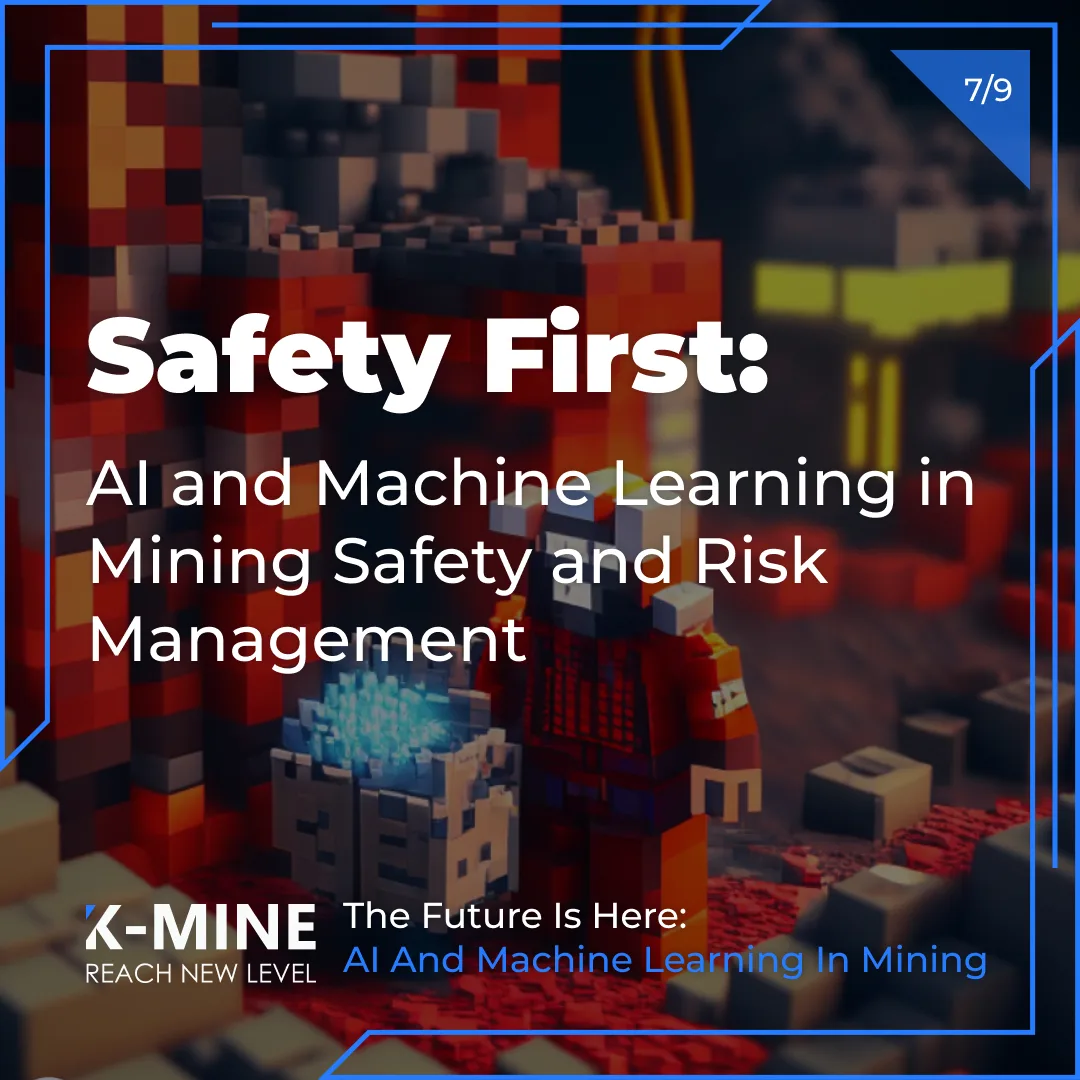
The Future is Here: AI and Machine Learning in Mining. Part 7
Content
Mining has long been recognized as a high-risk industry. With inherent dangers at every turn – from hazardous terrains to the handling of explosive materials – maintaining the safety of workers and equipment is paramount. Traditional safety measures have come a long way in managing these risks, but there’s always room for improvement. It is here that the cutting-edge technologies of Artificial Intelligence (AI) and Machine Learning (ML) are stepping up to the plate, aiming to further bolster safety and mitigate risks in the mining sector.
The promise of AI and Machine Learning is considerable, offering the potential to transform the way we approach safety and risk management in mining operations. From predicting safety incidents to promoting a culture of safety, these technologies are opening up new possibilities for keeping mining personnel safe and equipment in peak condition. So, let’s dive in to explore how the mining industry is leveraging AI and Machine Learning to put ‘Safety First’.
Understanding Safety and Risk Management in Mining
In the high-stakes world of mining, safety isn’t just a priority—it’s a necessity. Traditional approaches to safety and risk management in this sector have evolved over time, honing in on the hazards that come hand in hand with mining operations. These measures encompass a range of practices—from routine equipment checks and meticulous training programs, to stringent compliance with safety regulations and emergency response plans.
Risk management, on the other hand, focuses on identifying, assessing, and controlling threats to a mine’s capital and earnings. These risks could range from operational hazards, such as equipment failure and accidents, to financial and environmental risks.
Despite these comprehensive measures, the dynamic nature of mining operations, coupled with their often harsh and unpredictable environments, means that risks can never be entirely eliminated. The limitation of these traditional approaches lies in their reactive nature—they are often implemented in response to incidents or accidents that have already occurred.
Moreover, human error, unpredictability of natural conditions, and the ever-present element of surprise inherent in deep earth excavation further complicate these challenges. The question, therefore, isn’t just about how we respond to these risks, but whether we can anticipate them to prevent or mitigate their impact. And this is where the prospect of AI and Machine Learning in mining safety and risk management comes to the fore.
AI and Machine Learning in Risk Assessment
Harnessing the power of AI and machine learning, the mining industry is steadily making strides towards proactively identifying risks before they evolve into detrimental incidents. These advanced technologies bring a paradigm shift, transitioning from the traditional reactive approaches to a more predictive stance on safety and risk management.
In the realm of risk assessment, machine learning algorithms are trained to learn from vast amounts of historical data collected from various mining operations. These datasets can encompass various factors such as the type of machinery used, geological information, past incidents, operational parameters, and more. By learning patterns and correlations from this data, these algorithms can predict potential safety risks and hazardous conditions that could emerge in future operations.
Artificial Intelligence, with its capability to process and analyze enormous amounts of data at an unprecedented speed, allows for real-time risk assessment. By continuously monitoring various data points such as equipment vibration, temperature, noise levels, and operator fatigue, AI systems can provide timely alerts about potential equipment failures or safety hazards.
In addition, these systems can simulate different mining scenarios, weighing the potential risks against the anticipated benefits. This proactive approach not only allows for more effective risk management but also aids in decision-making processes, helping to choose the safest and most efficient methods of operation.
From detecting patterns in safety incidents, predicting machinery breakdowns, to assessing the stability of mining structures, AI and machine learning open up new avenues in risk assessment, making mining operations safer and more reliable.
Predicting Safety Incidents with AI
One of the game-changing applications of AI and machine learning in the mining sector is their capability to predict safety incidents. By leveraging these technologies, mining companies can switch from a reactive approach to safety—dealing with incidents after they occur—to a proactive one, anticipating and preventing potential incidents before they happen.
Machine learning algorithms, trained on extensive datasets that include details of past incidents, near misses, operational parameters, and worker behaviors, can uncover subtle patterns and trends that might be overlooked by human analysis. These algorithms can predict the likelihood of incidents occurring under certain conditions or identify the factors that significantly contribute to safety risks.
For instance, machine learning can analyze data from wearable technology, used by miners to monitor vital signs like heart rate, body temperature, and fatigue levels. Irregularities in these metrics can indicate a potential health risk or an increased likelihood of human error. Therefore, by analyzing this data, AI can alert supervisors to intervene or mandate rest periods, thereby preventing incidents caused by worker fatigue.
Similarly, machine learning can help predict equipment-related incidents. By continuously monitoring equipment performance data and operational conditions, these algorithms can predict potential equipment failure, allowing for preventive maintenance and, consequently, reducing the risk of accidents caused by equipment malfunction.
Overall, the predictive capabilities of AI and machine learning not only allow for more effective safety measures but also contribute to a safer working environment and a robust safety culture in mining operations. They ensure that safety is not just about responding to incidents, but anticipating and avoiding them.
Promoting a Culture of Safety with AI and Machine Learning
Beyond its applications in risk assessment and incident prediction, AI and machine learning have another vital role to play in enhancing mining safety: fostering a robust culture of safety within mining operations. By incorporating these technologies into safety training and drills, mining companies can enhance the effectiveness of these programs, leading to a safer and more aware workforce.
Machine learning algorithms can be used to create adaptive training programs, adjusting content based on individual learning progress and comprehension. This personalization ensures each worker receives training tailored to their needs, improving knowledge retention and application in real-life situations.
Moreover, AI can analyze past incidents and near misses, using this data to simulate potential safety scenarios for training purposes. These realistic simulations, combined with immersive technologies like Virtual Reality (VR), can provide a safe environment for workers to practice their responses to different safety risks, increasing their preparedness for real-life incidents.
In addition, machine learning can provide insightful analysis of safety drill effectiveness. By analyzing data collected during drills, such as response times and procedural adherence, these algorithms can highlight areas for improvement and track progress over time. This continual feedback loop ensures that safety drills remain relevant and effective.
In these ways, AI and machine learning help transform safety from a set of guidelines to an integrated part of the mining operation culture. By making safety training more personalized, realistic, and adaptable, these technologies empower workers to take ownership of their safety and that of their peers, resulting in a safer working environment for all.
Challenges and Future Directions
As promising as the application of AI and machine learning in mining safety and risk management may be, it is not without its challenges. The successful deployment of these technologies hinges on a number of factors.
Firstly, the collection and quality of data are key considerations. A significant amount of data is needed for machine learning algorithms to function optimally, and this data needs to be accurate and comprehensive. Mining companies must therefore establish reliable data collection processes, ensuring all pertinent safety data is captured. In some cases, this may require investments in new sensors or data management systems, or modifications to existing processes to capture additional data points.
Integration with existing systems can also present a challenge. Mining operations often rely on a mix of technologies, and integrating new AI and machine learning solutions with existing systems can be complex. Solutions need to be interoperable, and care must be taken to ensure data security and privacy.
Finally, a lack of in-house expertise can be a hurdle. While there are many tools available to develop and deploy AI and machine learning solutions, they typically require a degree of technical knowledge to use effectively. Mining companies may need to invest in training or hire new personnel to fully utilize these technologies.
Despite these challenges, the future of AI and machine learning in mining safety and risk management is bright. Advancements in these technologies are likely to make them more accessible and effective. In addition, the growing recognition of the role that a strong safety culture plays in successful mining operations is likely to drive further adoption of these technologies. As these trends continue, we can expect AI and machine learning to play an increasingly important role in promoting safety in the mining industry.
Conclusion
This journey through the intersection of safety, risk management, and the promising technologies of AI and machine learning has highlighted the transformative potential these tools hold for the mining industry. With the ability to augment traditional approaches, AI and machine learning provide innovative solutions to the age-old challenges of ensuring safety and mitigating risks in mining operations.
By enhancing risk assessment procedures, these technologies allow for a more dynamic, data-driven approach to identifying potential hazards. Furthermore, the predictive capabilities of AI and machine learning stand to revolutionize how the industry anticipates and mitigates safety incidents. Such proactive measures could significantly reduce accident rates and foster safer working conditions.
Moreover, the potential of AI and machine learning extends to promoting a culture of safety within mining operations. By providing more effective training tools and reinforcing safety protocols, these technologies can help to instill safety values at all levels of operation.
Certainly, the path towards widespread adoption of AI and machine learning in mining safety and risk management comes with its challenges, including data collection, system integration, and expertise requirements. However, as the technology continues to evolve and its advantages become more apparent, we can expect a future where AI and machine learning become standard tools in mining safety and risk management.
Looking ahead, our final topic in this series will delve deeper into the uses of AI and machine learning in another critical aspect of mining. Stay tuned as we continue our exploration into this fascinating subject.



 Back
Back